How does Lumoz stand out from the current node sales war?
Why do many project owners with complete technical backgrounds have a special liking for node sales recently?
 JinseFinance
JinseFinance
Introduction
With the rapid penetration of modular blockchain into L2, the maturity of various RaaS tools, and the implementation of the Cancun upgrade, the threshold for building L2 has been greatly reduced, and technology is no longer the main obstacle to building Rollup.
In addition, emerging Rollups such as Base, Manta Pacific, and Blast have achieved rapid rise by using existing tools to build Rollup at low cost and shifting the focus of the project to the ecosystem, which has set a benchmark for the market. The transformation of traditional applications to L2 and the outbreak of various lightweight L2s seem to have become an irreversible trend.
In terms of the technical route of Rollup, there has long been a dispute between OP and ZK. Vitalik has repeatedly expressed the view of "short-term OP, long-term ZK" because ZK-Rollup still has many technical issues to be resolved.
With the advancement of technology, the infrastructure construction related to ZK-Rollup has become more mature. Rollup using ZK solution is very likely to occupy an important market share in the future L2 blowout. As the leading RaaS focusing on ZK, Lumoz has great potential to succeed in the near future.
Bottlenecks of ZK-Rollup
2.1 Rollup from a modular perspective
Readers may already be clear about the basic principles of OP-Rollup and ZK-Rollup. Here we will understand Rollup again from a modular perspective.
Rollup essentially achieves the optimal allocation of resources through modular division of labor, allowing different participants to focus on one task, thereby improving overall efficiency.
The modular structure of Ethereum can be simply broken down into: data availability layer DA, consensus layer Consensus, settlement layer Settlement, and execution layer Execution.
Execution layer
Provides an execution environment to calculate transactions, convert old states to new states, submit new states to the settlement layer, and fraud/validity proofs.
The execution layer can be further divided into sequencers and provers. Sequencers are responsible for calculating state transitions, while provers are responsible for generating proofs (especially ZK-Rollup, because the calculation type and overhead of generating proofs have certain hardware requirements).
Settlement Layer
Verify the correctness of the state transition of the execution layer calculation. Generally, it is a smart contract deployed on Layer1, which is responsible for verifying the calculation of the execution layer; the state hash of the verified Rollup block will be recorded on the chain, and the block generated by the Rollup obtains the finality.
For ZK-Rollup, the contract writes the verification algorithm of the ZK Proof submitted to a specific ZK-Rollup. After the ZK-Rollup completes the execution, it submits the state hash and ZKP to the contract, triggering the verification transaction. When the verification passes, the state hash is proved to be valid and the block obtains Finality.
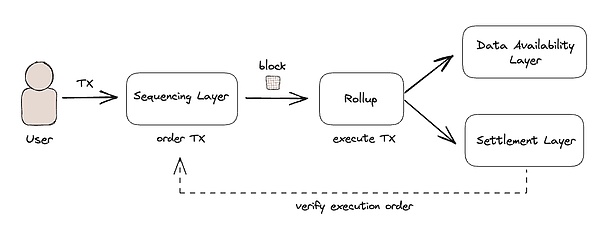
(Source: https://docs.theradius.xyz/overview/introduction-to-radius)
Consensus Layer
In most cases, the consensus layer is undertaken by Layer1. The state hash verified by the consensus layer is recorded on the chain, and the corresponding transaction block on the Rollup obtains the security protected by Layer1.
Data Availability Layer DA
Saves the transaction data in the Rollup block and provides it to anyone so that they can reconstruct the Rollup transaction at any time. The DA layer can be Layer1, or a dedicated DA layer such as Celestia, EigenDA, or a more centralized data availability committee, etc.
2.2 Difficulties in the Popularization of ZK-Rollup
Although ZK-Rollup has many advantages and is regarded by Vitalik as a long-term Ethereum expansion solution, the many technical difficulties it faces limit its large-scale adoption at this stage.
For example, the cost of calculating ZKP is too high, zkEVM is too complex, and ZKP calculations have high hardware requirements that may lead to centralization, etc.
The cost of calculating ZKP is high
ZKP is computationally intensive. Taking zk-SNARKs, the most popular ZK algorithm, as an example, the production of ZKP actually converts the execution process of the program into a verifiable proposition.
This proposition will be abstracted into a set of polynomial equations. In order to prove the correctness of the program execution (the existence of polynomial solutions), pairing operations are required on the elliptic curve.
The generation of polynomials and elliptic curve pairing are very computationally intensive because they require a large number of algebraic operations.
In terms of hardware requirements and execution time, this computational complexity leads to high hardware requirements. Ordinary hardware may have difficulty completing these calculations in a reasonable time, especially when processing a large number of transactions.
The time to generate a zk-SNARK proof is much longer than the time to execute the original program (excluding the proof process). Depending on the implementation and transaction complexity, the time to generate the proof may be hundreds to thousands of times the original calculation time.
ZKP computations require high hardware and may lead to centralization
Due to the high computational cost and hardware requirements of ZKP, small-scale Rollup operators may find it difficult to afford the necessary investment to become a prover.
In this case, only a few participants with high-performance computing resources can effectively generate proofs, leading to a trend of centralization in ZK-Rollup. This centralization may be contrary to the decentralized spirit of blockchain and may introduce risks of single point failure and censorship.
zkEVM is too complex
In terms of design compatibility, EVM was not designed to be compatible with zero-knowledge proof technology. EVM is a stack-based virtual machine that supports a series of opcodes for executing smart contracts.
In order for any program executed by the EVM to generate valid proofs through zk-SNARKs, it is necessary to create corresponding mathematical representations and proof logic for each opcode of the EVM. This not only requires complex cryptographic transformations, but also challenges the compatibility of existing smart contracts.
Implementing zkEVM requires extensive mathematical modeling of EVM opcodes to convert program execution into a form that can be proven by zk-SNARKs.
This includes simulating EVM state transitions, memory operations, and contract calls. Given the flexibility and complexity of the EVM, this task is extremely arduous. At the same time, maintaining the efficiency and security of zkEVM and ensuring that it can generate small, verifiable proofs is also a major challenge.
How Lumoz solves the bottleneck of ZK-Rollup's popularity
Lumoz is a decentralized ZK-RaaS (ZK-Rollup as a Service) platform, and also a PoW (Proof of Work) network to support ZKP (Zero Knowledge Proof) mining.
In order to solve a series of challenges faced by ZK-Rollup, Lumoz introduced the concept of ZK-RaaS. The service enables developers to launch their zkEVM chain in one minute without having to understand ZK or chain nodes in detail.
Lumoz also introduced the concept of ZK-PoW, inviting miners to participate in maintaining zkEVM and calculating ZKP. Lumoz aims to simplify the use of ZK-Rollup and promote its wider adoption, thereby promoting the large-scale deployment of zkEVM-based application chains.
Developers can deploy their ZK-Rollup (zkEVM) on multiple chains with a single click of a button. For miners, Lumoz, as a multi-chain PoW protocol, supports ZK mining on various public chains and generates zero-knowledge proofs for ZK-Rollup.
3.1 ZK-PoW Cloud: Solving the ZK Computing Power and Centralization Problem
The problem of ZK computing power and centralization is essentially that ZKP computing requires high computing power, and the hardware threshold leads to the centralization problem.
Lumoz uses the ZK-PoW mechanism to incentivize miners to provide ZKP computing power and provide comprehensive hardware infrastructure for ZK-Rollup, which is one of the core concepts of Lumoz.
All participants, including users, developers, and miners, can benefit from Lumoz's economic model and promote the large-scale application of ZK-Rollup.
Lumoz's utilization of existing hardware resources
After the transition from Ethereum PoW to PoS, many Ethereum mining machines have lost their application scenarios. The value of these mining machines is about US$12 billion in capital scale, and many of them are currently idle. With the large-scale implementation of ZK-Rollup, generating ZKP requires a large amount of hardware and mining machines, such as CPU, GPU, and FPGA, to provide computing power.
Lumoz optimized ZKP algorithm, lowering the threshold for miners to participate and improving expansion efficiency
Proposed a two-step submission mechanism for ZKP verification to lower the threshold for miners to participate
In order to encourage more miners to participate in ZKP computing tasks at the same time, Lumoz proposed a two-step submission mechanism for ZKP verification.
Submit proofhash: Within a certain time frame, multiple miners can participate in ZKP calculations, instead of letting the miner who first calculates ZKP get the reward immediately. This design allows for wider participation, not just limited to the miners with the strongest computing power. After completing the ZKP calculation, miners do not immediately submit the original proof they calculated, but first hash this proof and their own address (proof/address) to generate a hash value called proofhash. Then, they submit this proofhash to a specific contract on the blockchain. This step does not need to reveal the specific content of the proof, ensuring the security and efficiency of the submission process, and allowing more miners to participate in the calculation.
Submit ZKP: After the time range ends, the miner submits the original proof and compares it with the previously submitted proofhash for verification. This step ensures that the submitted proof is the one declared in the first step, preventing cheating. Miners who pass this verification will receive PoW rewards, and the amount of rewards is distributed according to the miners' rights and interests. It is not only the miners who calculate ZKP first who receive rewards.
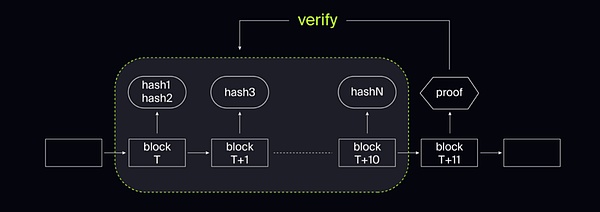
(Source: https://docs.lumoz.org/v/zhong-wen-jian-ti/lumoz-bai-pi-shu-v2)
Optimize ZKP generation algorithm and improve proof efficiency
When the Rollup smart contract verifies ZKP, if the original proof is submitted, it may trigger an on-chain attack. To avoid such attacks, ZK-Rollup often performs additional operations to obfuscate the original proof data. Lumoz's innovative two-step submission algorithm for ZKP adopts a "submit first, then verify" approach to avoid unnecessary aggregation calculations of proofs and addresses.
In some open source zkEVMs, ZKP calculations and submissions are performed sequentially. This can become a bottleneck when a ZK-Rollup submits a large number of sequences, as miners cannot calculate multiple ZKPs in parallel. Lumoz's two-step submission algorithm implements parallel calculation and sequential submission of ZKP, enabling miners to perform multiple ZKP generation tasks simultaneously, significantly improving ZKP generation efficiency.
The Lumoz team also improved the ZKP recursive aggregation algorithm, significantly improving the utilization of machine resources in the cluster and further speeding up ZKP calculations. Stress tests conducted in a real environment showed that a rate of 27.8 transactions per second could be maintained in about 40 minutes using a cluster of 20 machines (each equipped with a 128-core CPU and 1TB of memory). Under similar conditions, Lumoz successfully reduced the average transaction confirmation time from about 5-6 minutes to about 3 minutes, increasing the efficiency of ZKP generation by about 80%.
With the participation of more and more ZK-Rollups and miners, the demand and supply scale of the ZKP computing power market will continue to expand, making the efficiency improvements provided by Lumoz's PoW algorithm more significant.
3.2 ZK-RaaS: Solving the Development Threshold
One-click ZK-Rollup Generation
The ZK-RaaS (ZK-Rollup as a Service) provided by Lumoz provides a one-click ZK-Rollup generation service for all users.
Lumoz provides a universal ZK-Rollup launchpad that enables developers to easily deploy different types of ZK-Rollups to different base chains.
These base chains include Ethereum, Lumoz chain, BNB chain, Polygon PoS, and other public chains.
Types of ZK-Rollup (zkEVM) include zkSync, Polygon zkEVM, Scroll, StarkNet and other zkEVM, as well as various other ZK-Rollups.
Convenient management of ZK-Rollup
Lumoz deploys a Rollup System Contract (RSC) on each base chain to manage the life cycle of the Rollup on that chain, including registration, suspension, and revocation.
By leasing a Rollup slot with a certain amount of MOZ (Lumoz native token), developers can own a ZK-Rollup.
The concept of a Rollup slot is similar to a slot in Polkadot or an application chain in Cosmos. However, Cosmos' application chain needs to maintain its own consensus layer and cross-chain bridge, which poses a greater security risk. In contrast, ZK-Rollup applies ZK technology to mathematically ensure the sharing of the consensus and data availability layer between Rollup and the base chain. This approach is safer, more decentralized, and has lower maintenance costs.
After leasing a Rollup slot, developers gain an independent execution environment and can own a unique ZK-Rollup chain. Developers have full control over ZK-Rollup and customize its economic model, including choosing the GAS token. They can freely adjust the GAS fee or even set it to zero, making it free for users to use.
Low Cost
Developers do not need to bear any hardware costs. All hardware resources, such as data availability, serializers, and ZKP computing power, are provided and decentralized by the Lumoz ZK-PoW cloud.
Interoperability
Local cross-Rollup communication is possible between different ZK-Rollups on different base chains. This is a message communication mechanism that enables an address on one Rollup to interact directly with a contract on another Rollup. This feature greatly solves the fragmentation problem of user assets and enhances interoperability between applications.
3.3 Lumoz Chain: Further Optimization of ZK-Rollup Built on Lumoz
Lumoz chain is one of the base chains supported by Lumoz. It adopts a hybrid consensus model of PoS and PoW. It not only supports Lumoz ZK-PoW cloud, but also provides further optimization for ZK-Rollup.
Optimization of ZK-Rollup performance
These optimizations include the use of precompiled contracts to accelerate ZKP verification, data sharding support, and PoS consensus based on ETH 2.0. In the future, support for EIP-4844, DankSharding, and other fully sharded solutions will also be expanded, which may reduce the GAS cost of Rollup to near zero.
A decentralized sequencer solution
Let the block proposers of the Lumoz chain also propose blocks for the Rollup layer, effectively separating the roles of builders and proposers.
Builders are supported through a permissionless P2P network, while proposers rely on the block proposers of the Lumoz chain. This approach eliminates the availability risk of a single node while maintaining resistance to Miner Extractable Value (MEV) and censorship.
The Lumoz chain provides a standardized decentralized serialization mechanism in which block proposers also propose blocks for Rollup. In this way, ZK-Rollup inherits not only the security from higher layers, but also its degree of decentralization.
In the Lumoz chain: Lumoz allows anyone who holds Lumoz tokens to become a validator, and validators can receive block rewards and gas fees from the Lumoz chain.
In the Rollup layer:
PoS (Serializer): Validators propose blocks in the Lumoz chain and the Rollup layer (i.e., data batches). Therefore, they also act as sequencers in the Rollup layer, where they can receive GAS fees from transactions.
PoW (Prover): Any individual with sufficient computing power to perform ZKP calculations can become a prover in the Rollup layer. According to the PoW rules, the prover generates zk proofs from the Rollup layer blocks submitted by the serializer.
ZK-Rollup is similar to a computer, where the hard disk represents the data availability provided by PoS, while the CPU reflects the computing power granted by PoW.
The mission of the Lumoz chain is to strike a balance between PoS and PoW, enabling all participants to maximize their contributions and benefits, thereby improving the performance and user experience of large-scale ZK-Rollup networks.
Market landscape and Lumoz's unique entry point
Looking at the RaaS and modular tracks, the current market competition has become fierce. The settlement layer is already a game for big players such as ETH, Optimism, and Arbitrum;
interoperability includes asset cross-chain bridges such as Mini Bridge, Orbiter, and Connext, as well as cross-chain communication projects such as Layzero and Chainlink CCIP;
the DA layer has been absolutely occupied by projects such as Celestia and EigenDA; at the Rollup stack level, most Rollup projects, and even RaaS providers, rely heavily on development kits provided by L2 such as Optimism, Arbitrum, Polygon, and zkSync, which has also led to the homogenization of RaaS projects that are purely development tools;
at the decentralized sorter level, there are also cutting-edge projects such as Altlayer and Espresso that have gained first-mover advantages.
Homogeneity and oligopoly are more obvious characteristics of the RaaS and modular tracks. New projects need to have unique entry points and forward-looking layouts to break through.
The combination of computing power modules and RaaS launched by Lumoz can solve a series of pain points of ZK-Rollup in one stop, and promote the rapid popularization of ZK-Rollup.
At present, in the subdivision of ZK-Rollup RaaS, Lumoz is already a leading "integrated" platform. With the increase in the penetration rate of ZK-Rollup, Lumoz will have great potential to grow into the most dazzling player in the ZK-Rollup subdivision track.
At the level of comparable projects, it is reasonable to compare Lumoz to AltLayer in the ZK track. AltLayer has a similar positioning to Lumoz. Neither is a simple RaaS project, but it empowers RaaS through a certain feature to provide customers with more comprehensive services, thereby gaining an advantageous market position.
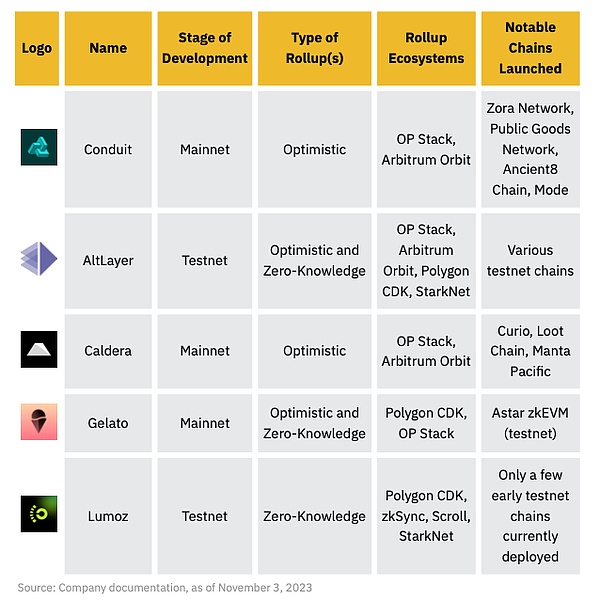
(Source: Binance Research)
AltLayer has achieved a certain market position by empowering RaaS through a heavy pledge sequencer based on EigenLayer. Lumoz helps ZK-Rollup projects solve computing problems after launch by sharing ZK computing power.
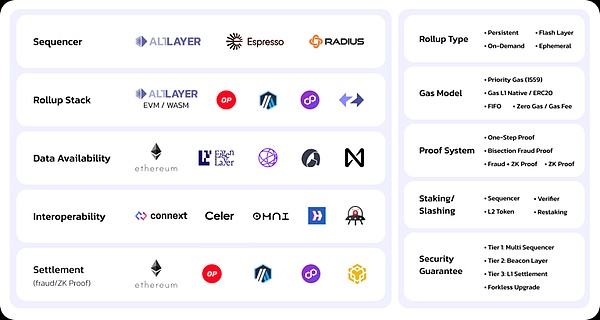
(https://docs.altlayer.io/altlayer-documentation)
AltLayer's current MC has reached 670 million US dollars, and its FDV has exceeded 5.3 billion US dollars. AltLayer's market performance demonstrates the high value capture of the RaaS track. Similarly, Lumoz, as the current leading player in the ZK RaaS track, will surely achieve impressive market performance when ZK-Rollup breaks out by integrating ZK computing power and RaaS services.
Project Background
Lumoz was formerly known as Opside, and its past business was also the ZK-RaaS platform. On April 8 this year, Lumoz disclosed that it had completed a new round of financing with a valuation of US$120 million, with participation from OKX Ventures, HashKey Capital, KuCoin Ventures, etc.
So far, Lumoz has raised as much as US$10 million. The third round of financing has been launched, and some institutions have confirmed their participation.
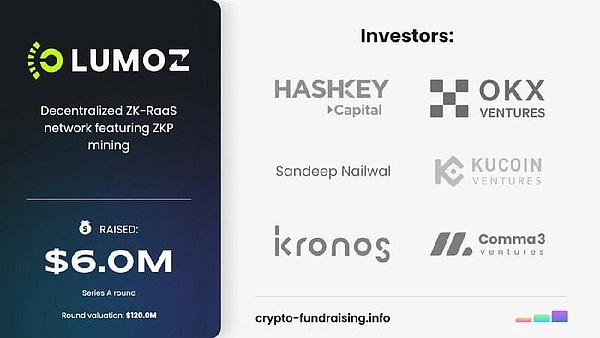
(Source: https://www.rootdata.com/Projects/detail/Lumoz?k=NTkxMQ%3D%3D)
Lumoz was able to quickly gain a leading edge in ZK computing modules and gain support from many leading institutions, stemming from its deep experience in ZK technology and PoW mining resources.
Before launching Lumoz, the team also participated in two ZK mining projects, 6block and zk.Work, demonstrating its leading position in ZK mining.

(Source: https://6block.com/)
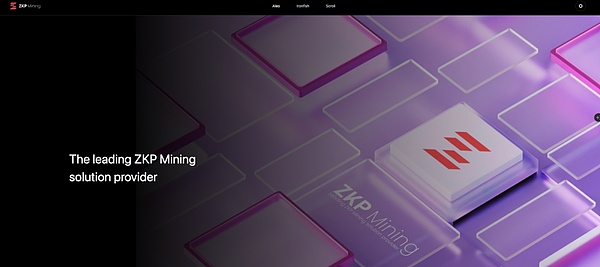
(Source: https://zkp.6block.com/)
Progress and Planning
With the support of excellent technology and resources, Lumoz has promoted the birth of many cutting-edge ETH L2 and BTC L2, such as ZKFair and Merlin Chain.
ZKFair:https://zkfair.io/
Merlin Chain:https://merlinchain.io/
The rapid rise of these projects shows that Lumoz's solid technical capabilities have been recognized by the market.
Currently, Lumoz's core component, Lumoz Chain, is in the Alpha Testnet stage. Its mainnet is scheduled to go online in July this year, and token generation is expected in August.
Lumoz attaches great importance to the construction of the ecosystem and the feedback of early users. Since August last year, Lumoz has launched the Gala Event, an incentive testnet event that lasted for 4 months, and achieved excellent results.
The Gala Event attracted nearly 700,000 community users to participate in the event, while 25,000 PoS nodes participated in network verification, and 145 miner entities contributed hash power to Lumoz. In addition, there are 15 zkEVM projects running stably based on the Lumoz chain.
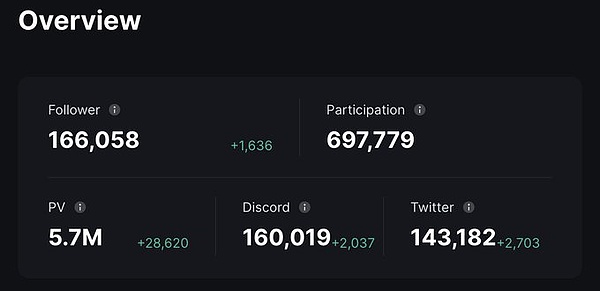
(Source: https://twitter.com/LumozOrg/status/1740925588003840194)
Currently, Lumoz is continuing to carry out Dragon Slayer activities with ZKFair and Glaxe to encourage user participation. The third phase of the activity is currently underway, which will award 25M Lumoz points and more than 8,000 USDC in rewards.
Within 24 hours of the launch of the third phase of the activity, more than 147,000 users have participated, which shows the popularity of the activity and the confidence of users in Lumoz.
Lumoz is expected to be launched on the mainnet in Q3. You can currently participate in Lumoz early through the Dragon Slayer activity.
Activity link:
https://dragon-slayer.zkfair.io/
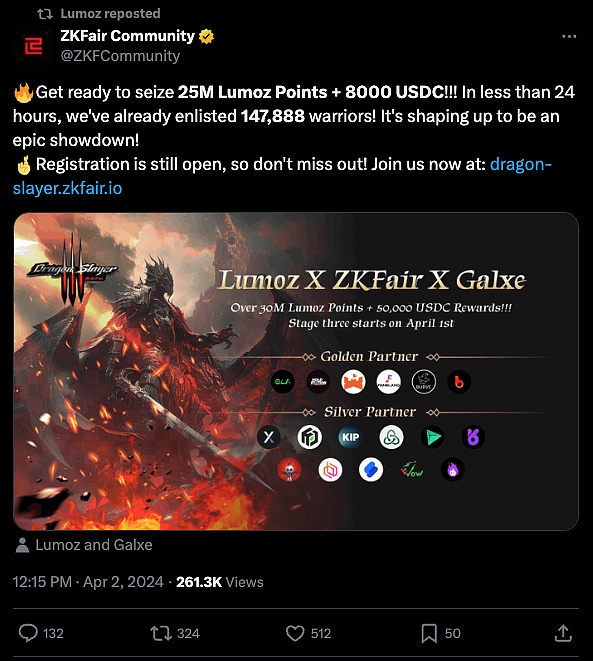
(Source: https://twitter.com/ZKFCommunity/status/1775014125263003766)
Conclusion and Outlook
With the maturity of ZK-related technologies, ZK-Rollup will gain a significant market share in the future Ethereum expansion market.
Lumoz's advanced judgment of the pain points and needs faced by ZK-Rollup has made it a pioneer and leader in this field. From the popularity of various activities, it is not difficult to see that users have fully recognized Lumoz.
With the Lumoz team's prediction of the market and deep relevant resources, we believe that Lumoz can become a leader in the ZK-RaaS track and promote the large-scale application of ZK-Rollup. Let us look forward to Lumoz's subsequent performance.
Why do many project owners with complete technical backgrounds have a special liking for node sales recently?
 JinseFinance
JinseFinanceThe Lumoz Network stands at the forefront of blockchain innovation as a globally distributed modular computing network. By integrating with the Decentralized Physical Infrastructure Network (DePIN), Lumoz offers a powerful, secure, and flexible computing platform designed to meet the needs of users worldwide.
 Wilfred
Wilfred Coinlive
Coinlive  Coinlive
Coinlive The rumors come hot on the heels of a Celsius financial report that exposes investors' transaction records.
 Beincrypto
BeincryptoBitbase is a cryptocurrency store and ATM company which has now decided to launch its ATM operations in Venezuela this ...
 Bitcoinist
BitcoinistThis CEO just got a job to oversee operations at this popular Chinese gaming and metaverse company. She is a ...
 Bitcoinist
BitcoinistBitcoin has been put to the extreme test during the past few weeks as this year's cryptocurrency market crash has raised ...
 Bitcoinist
BitcoinistWeb3 gaming console manufacturer Polium revealed their first product, the Polium One. This community-driven project aims to build the “world’s ...
 Bitcoinist
BitcoinistCrypto mining is a safe, legitimate experience enabling individuals to earn passive income and potentially build wealth from their investments. ...
 Bitcoinist
Bitcoinist